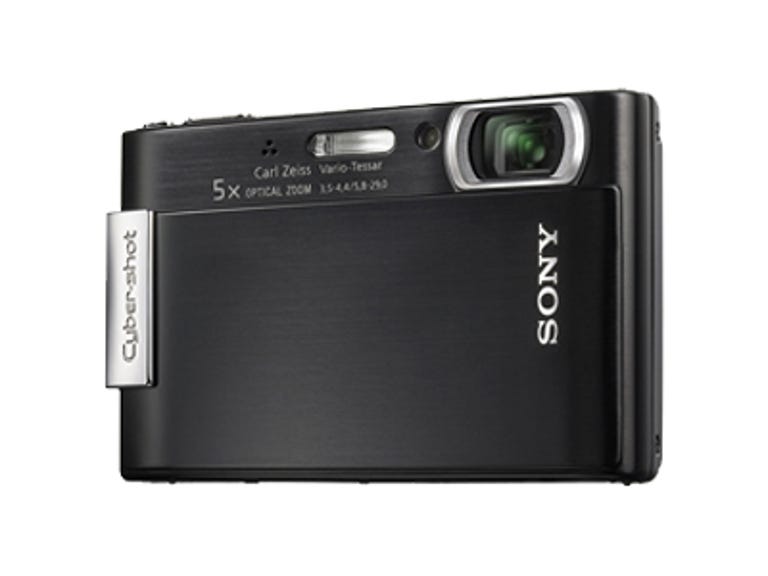 Why You Can Trust CNET
Why You Can Trust CNET Sony Cyber-shot DSC-T200 review: Sony Cyber-shot DSC-T200
Sony Cyber-shot DSC-T200
When I first heard that the T200 would use a touch screen rather than the T100's conventional button controls, I'll admit I was concerned. Sony's previous attempts to put touch screens in cameras, namely the DSC-T50, the DSC-N1, and the DSC-N2, met with less than ideal results. In those cases, the screen was more of a hindrance than a useful feature. Thankfully, Sony has managed to learn from its mistakes when developing the T200.
The Good
The Bad
The Bottom Line
It's still not perfect, but the T200's 3.5-inch touch-screen interface is miles better than the T50's and N2's controls. It still focuses too much on the screen itself, but the large icons and fairly direct menu system make it much more convenient than its predecessors. You can access most controls through the main screen, where large icons make easy targets, even for large fingertips. Like most new Cyber-shot cameras, the T200's system settings rest hidden in the device's PlayStation Portable-like Home menu, a slightly redundant submenu you probably won't access much except when turning off the camera's annoying beeps. Every other setting, from scene preset to ISO sensitivity, can be found with just a few taps of the screen.
The T200's 3.5-inch screen distinguishes itself as the largest we've seen so far on a T-series camera. Unfortunately, the screen completely dominates the camera's back panel and leaves little room for buttons on the device. Only the shutter release, power, playback, and zoom get their own physical buttons, relegating every other function to the touch screen. The shutter release feels comfortable enough, but the power and playback buttons sit flush with the camera's top edge, and are too narrow to push easily. Worse than that, the zoom rocker is no more than a tiny nub on the top-right corner of the camera. No larger than a grain of rice, the tiny toggle makes zooming in and out far more of a chore than it should be.
Technically, the T200 changes little from the T100 that came before it. It shares its predecessor's 8-megapixel CCD, 5x optical 35mm-to-175mm equivalent f/3.5-to-f/4.4 zoom lens, and Sony's Super SteadyShot optical image stabilization. Despite the larger LCD screen, the T200 even weighs about the same as its predecessor at just 6.5 ounces with battery and Memory Stick, compared with the T100's 6.1 ounces. If it wasn't for a small handful of quirky features, this camera would literally be a T100 with a touch screen.
Beside the usual center and 9-point autofocus modes, the T200 includes a touch-based spot autofocus. Tap the touch screen to set a spot on which the camera will then focus. The focus area has a border of about a centimeter from the top and bottom and half a centimeter from the sides of the picture, so you can't focus on edges or corners. The feature would be more useful if the camera had manual aperture control so you could set the depth of field, but it's still a nice touch, and lets you take some measure of control over the camera's focus without toggling between its four manual focus settings of 1 meter, 3 meters, 5 meters, and infinity.
Smile Shutter mode puts a unique spin on the camera's face detection feature. While in the mode, instead of pressing the shutter release to take a photo, the camera takes complete control, watching any faces in the frame and automatically taking shots when those faces smile. For the first iteration of a feature, Smile Shutter works surprisingly well. It usually takes less than a second to detect a smile and take a photo, though exaggerated grins tend to produce quicker response times. It sometimes trips up when the subject has a beard or his face is at an angle, but in general it functions admirably. Of course, now that cameras are taking photos for us, it begs the question of how long humanity will be part of photography. If Sony's next camera includes a "Find Sarah Connor" feature, we could be in trouble.
In our lab tests, the T200 generally maintained the sterling performance of its predecessor. After a 1.6-second wait from power-on to first shot, the T200 could snap a new photo every 1.4 seconds with the onboard flash turned off. With the flash enabled, that wait increased to a still-impressive 2.3 seconds. The camera's shutter lagged only 0.4 second with our high-contrast target and 1.2 seconds with our low-contrast target. In burst mode, the T200 captured 11 8-megapixel shots in 4.9 seconds, for a rate of 2.2 frames per second.
Unfortunately, the T200 doesn't live up to the picture-quality standards its predecessor set. The T200's photos all look much softer than those of its predecessor. Honestly, we're not sure why the T200's images are softer than those from the T100. Both cameras use the same sensor, the same lens, and the same Sony Bionz image processor. The T200 should take pictures as well as its older brother, but it just doesn't. On the bright side, the camera's photos are surprisingly free of noise at most sensitivity levels, but that might simply be a side effect of the softness. Other aspects of the image quality are just as good as they were in the T100.
If not for the softer images, the Sony Cyber-shot DSC-T200 would be a fine follow-up to the excellent T100. It shoots as fast, it offers more features, and, most amazingly, its touch-screen interface won't make you want to throw it out of a moving car. If you can still find it, you're better off with the T100. If you can't find it, though, or if you have a thing for touch screens, the DSC-T200 will probably satisfy your snapshot needs.
(Shorter bars indicate better performance)
| Typical shot-to-shot time | Time to first shot | Shutter lag (typical) |
(Longer bars indicate better performance)
